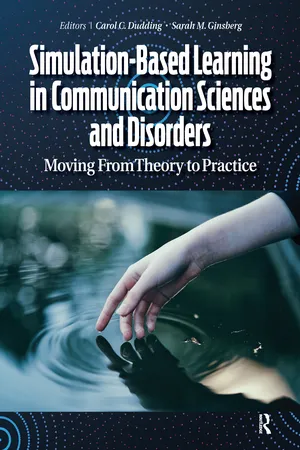
Simulation-Based Learning in Communication Sciences and Disorders
Moving from Theory to Practice
- 172 pages
- English
- ePUB (mobile friendly)
- Available on iOS & Android
Simulation-Based Learning in Communication Sciences and Disorders
Moving from Theory to Practice
About This Book
A new resource for academic and clinical educators, Simulation-Based Learning in Communication Sciences and Disorders: Moving From Theory to Practice presents best practices in simulations for undergraduate, graduate, and workplace training programs in audiology, speech-language pathology, and communication sciences and disorders.
Utilizing the expertise of experienced clinical educators, Simulation-Based Learning in Communication Sciences and Disorders is an introductory to intermediate text for those interested in implementing clinical simulations within undergraduate and graduate training programs, as well as the workplace. To that end, it includes descriptions of various simulation technologies, ranging from low to high fidelity, as well as examples for implementation.
The text is divided into three main sections:
- Foundations in Clinical Simulations provides an overview of foundational theories in simulation-based learning and principles of teaching and learning in higher education
- Clinical Simulation Learning Experiences expands upon the various forms of simulation technology, outlines the best practices for implementing simulations for learning, and identifies ways for educators to incorporate simulation technologies into their curriculum
- Professional Issues and Advocacy calls on readers to engage in professional development and research in the area of simulations; readers are encouraged to consider ways in which existing and emerging technologies can help us adapt to the upcoming changes in education and training
Simulation-Based Learning in Communication Sciences and Disorders: Moving From Theory to Practice is one of the first books to integrate best practices in simulation research and practice specifically for academics and clinical educators in communication sciences and disorders. It is an invaluable guide to anyone who is interested in providing high-quality learning experiences through simulation to students and professionals in communication sciences and disorders.
Frequently asked questions
Information
Table of contents
- Cover Page
- Half Title Page
- Title Page
- Copyright Page
- Dedication
- Contents
- Acknowledgments
- About the Editors
- Contributing Authors
- Introduction
- Part I Foundations in Clinical Simulations
- Part II Clinical Simulation Learning experiences
- Part III Professional Issues and Advocacy
- Glossary
- Financial Disclosure
- Index